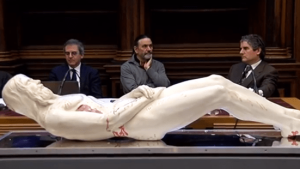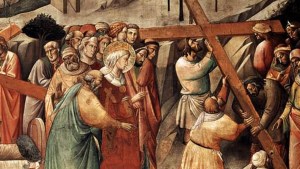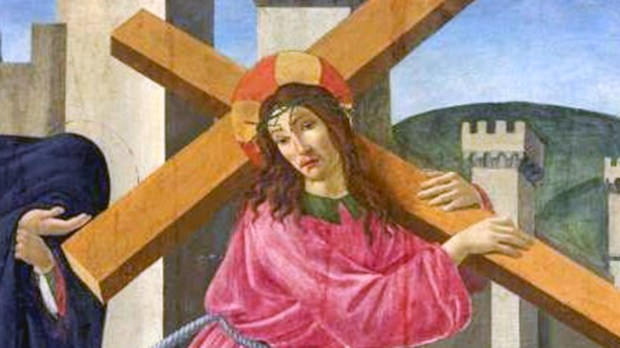In the Gospel accounts the authors record very little about Jesus’ road to Calvary and the cross he carried. Matthew, Mark and Luke note that Jesus was unable to carry the cross the entire way and had to be assisted.
They pressed into service a passer-by, Simon, a Cyrenian, who was coming in from the country, the father of Alexander and Rufus, to carry his cross. (Mark 15:21)
John’s account only mentions Jesus and how he took the cross upon himself and carried it to Calvary.
So they took Jesus, and carrying the cross himself he went out to what is called the Place of the Skull, in Hebrew, Golgotha. (John 19:16-17)
All of the narratives are silent about the details of the cross Jesus carried, likely because their audience, Jews and Greeks in the 1st century, were well aware of the Romans and their methods of torture. Crucifixion was a common penalty for criminals in the Roman Empire and was used as a public deterrent. Those who read/listened to the accounts of Jesus’ crucifixion did not need a detailed description as they knew exactly what it looked like.
Historian Hershel Shanks explains in an article in the Biblical Archeology Review that wood was difficult to acquire and that the Romans reused wooden uprights that were already fixed in the ground. This means anyone who was crucified only had to carry the crossbeam.
According to the literary sources, those condemned to crucifixion never carried the complete cross, despite the common belief to the contrary and despite the many modern reenactments of Jesus’ walk to Golgotha. Instead, only the crossbar was carried, while the upright was set in a permanent place where it was used for subsequent executions. As the first-century Jewish historian Josephus noted, wood was so scarce in Jerusalem during the first century A.D. that the Romans were forced to travel ten miles from Jerusalem to secure timber for their siege machinery.
At the same time, many scientists and historians have looked at the Shroud of Turin, which many believe is the shroud that covered Jesus in the tomb, and claim that the shroud provides evidence that Jesus carried the entire cross.

Read more:
This 3D “carbon copy” of Jesus was created using the Shroud of Turin
Writer Harrington Lackey explains how scientific studies of the shroud have confirmed the traditional artistic tradition of the Way of the Cross.
Using computer modeling, which analyzed the back of the Shroud, they discovered that there were more than two abrasion marks on the Shroud; there were nine blood marks which correspond to the tunic Jesus was wearing (John 19:23-24). Marks on the tunic indicate a cross pattern, created by the pressure of the whole cross- the pitabulum and the stipes – on his back, despite the tunic which buffered the bruises.
This theory also corresponds to Jewish laws about the presence of unclean objects.
It has also been speculated that Jesus had to carry the entire cross, because the filthy, used stipes, covered in blood and feces were pulled out of their holes in the ground and stored. This was probably done because in and around a holy site like Jerusalem, the religious law forbid anyone touching anything unclean. So, Jesus and the two thieves crucified with him had to carry both stipes and pitabulum. In more secular places around the Roman Empire, the filthy stipes stood in the ground waiting for its next victim.
While we may never know the full truth about which cross Jesus carried on this earth, the most important part is that Jesus carried that cross to save the world, forgive our sins and open the gates of Heaven.
[H]e was pierced for our sins, crushed for our iniquity. He bore the punishment that makes us whole, by his wounds we were healed. (Isaiah 53:5)

Read more:
What happened to the True Cross of Christ?

